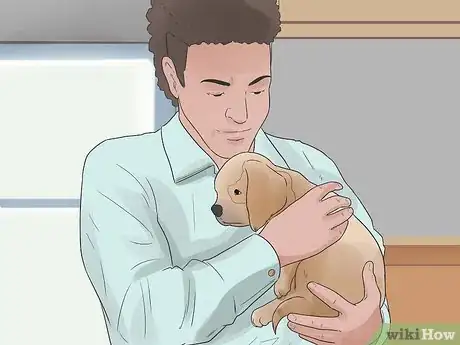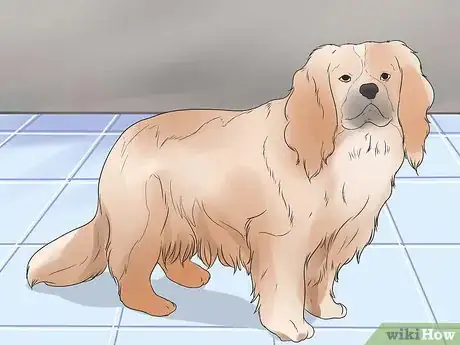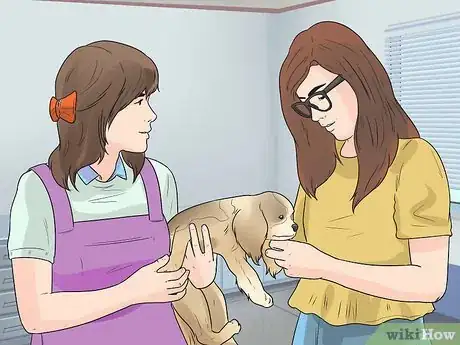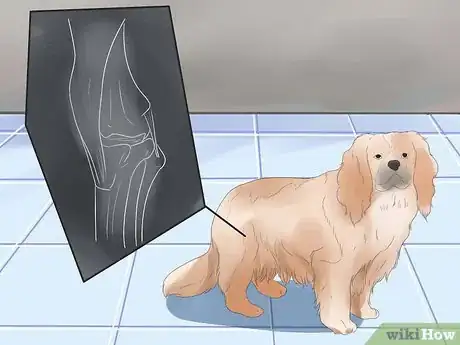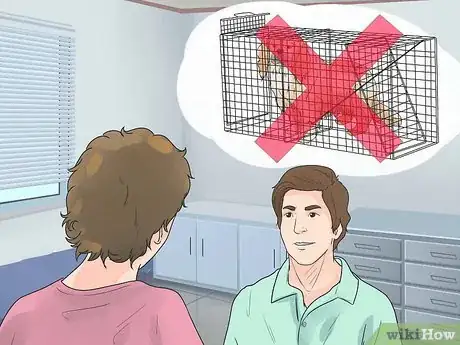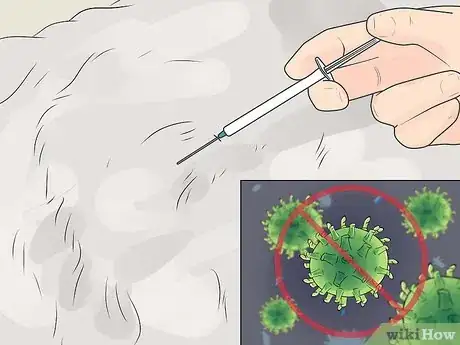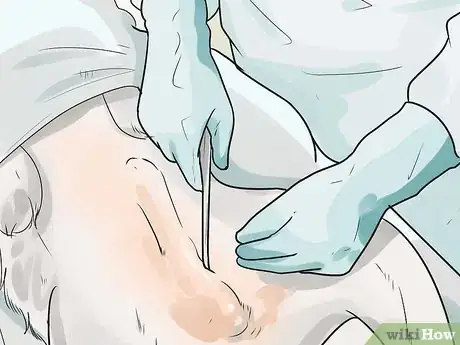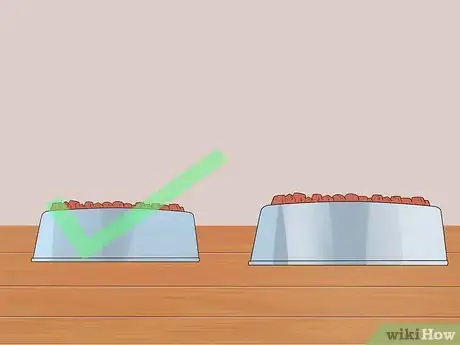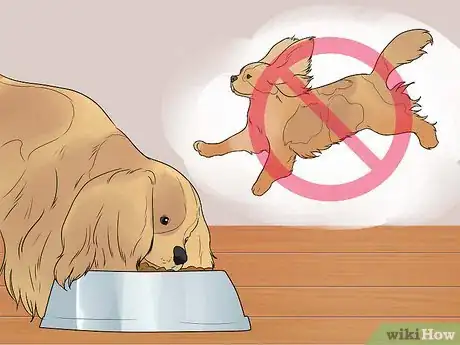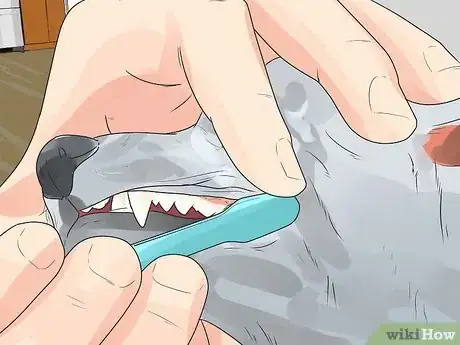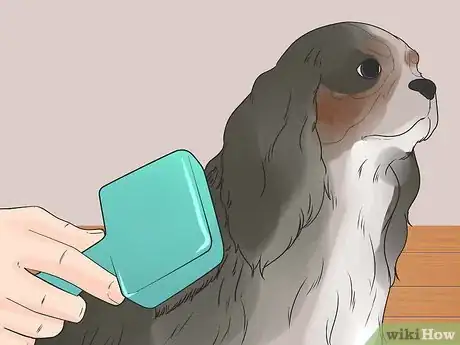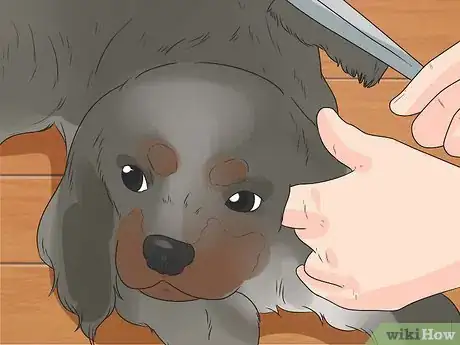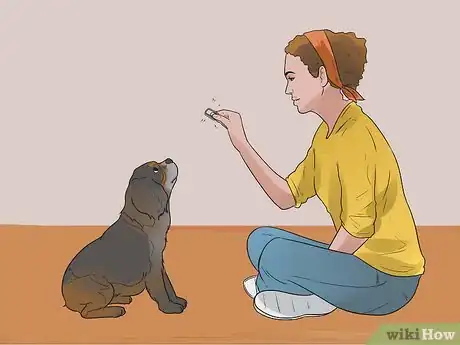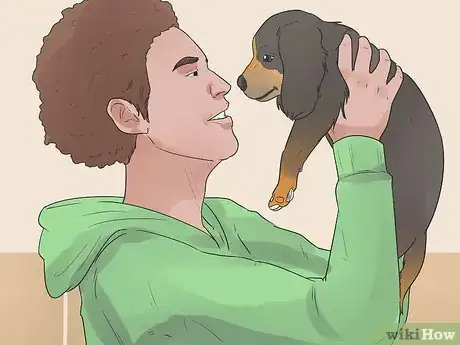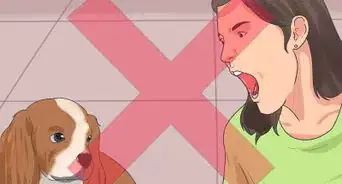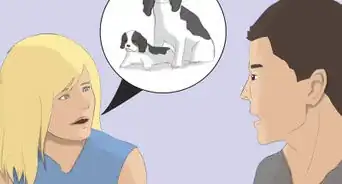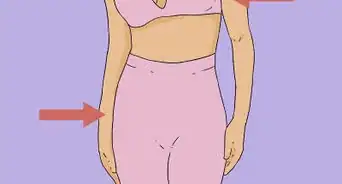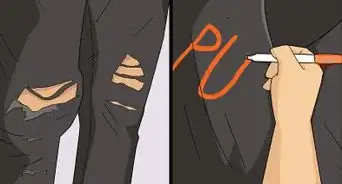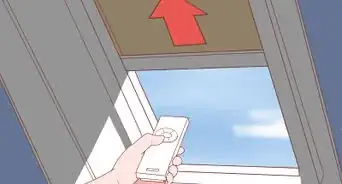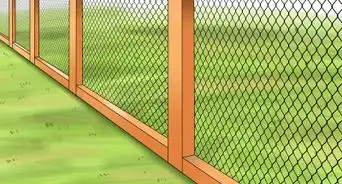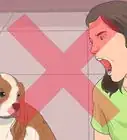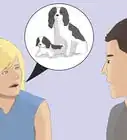This article was co-authored by Pippa Elliott, MRCVS. Dr. Elliott, BVMS, MRCVS is a veterinarian with over 30 years of experience in veterinary surgery and companion animal practice. She graduated from the University of Glasgow in 1987 with a degree in veterinary medicine and surgery. She has worked at the same animal clinic in her hometown for over 20 years.
This article has been viewed 25,339 times.
The Cavalier King Charles Spaniel is a beloved dog breed that has its roots in 17th century England, where it was a favorite of King Charles II. This small to medium sized dog originates from spaniel stock, which shows itself from time to time in its love of being outdoors and playfully chasing after balls. However, their real forte is in being a loving companion, content to trot next to its master and submit to belly rubs. This breed has an enviable reputation for being truly gentle and has the perfect temperament to be an ideal family dog.[1]
Steps
Choosing a Cavalier King Charles Spaniel
-
1Consider your needs from a dog. The ideal Cavalier owner is reasonably active and looking for a dog with a rock-solid gentle temperament to make a good companion for a family. If you are looking for a guard dog, then the Cavalier is definitely not for you, as it is likely to welcome a thief with a lick and a waggy tail. Also, if you wish to go running or hiking with a Cavalier, they are likely to tire and you are better suited to a larger dog. However, if you need a dog that will play heartily and enjoys a good walk but without needing excessive amounts of exercise, then a Cavalier is a good choice.
-
2Decide whether the physical attributes of a Cavalier are desirable to you. Generally, the Cavalier is a small dog with a long coat. The Cavalier belongs to the toy group of dogs and weighs around 5.4 - 8.0 kg. They have a moderately long coat that is soft and silky.
- The colors recognized by the US Kennel Club are Blenheim (chestnut markings on a white background), tricolor (black, tan and white), ruby (tan), and black and tan.[2]
Advertisement -
3Choose a breeder that has a track record of healthy and ethical breeding. In practical terms, when choosing a puppy find a breeder who can show that their dogs are free of disease both now and in previous generations. This can be tricky to do, as there is no certified system, but a responsible breeder will be able to prove their dogs have had regular vet checks and no problems were found at annual vaccinations.
- Unfortunately there is currently no screening tests that are practical for breeders in order to ensure their breeding stock are clear of many problems common to Cavaliers. The only option for some diseases is for breeders to screen their breeding stock with an MRI scan, but this is costly and thus not normal practice.[3]
- With regards to heart disease, the symptoms usually develop in middle age onwards, and so it can be difficult to guarantee a parent is free from heart disease early in its life (when it is likely to have pups).[4]
-
4Make sure a potential breeder socialized its puppies. Be aware how important socialization of the puppy is, when it comes to the Cavalier growing into a confident well-adjusted adult dog. The breeder should make efforts for as many different people as possible to meet the puppies from around 3 - 4 weeks of age, so the young dogs are used to people of different heights, appearances, and tones of voice.
- The puppies should not be exclusively reared in a kennel, as this isolates them from the normal sights, sounds, and activities of a domestic house, and they will find it more difficult to adjust to family life.
-
5Have any potential dogs screened for disease or hereditary problems. Even if a breeder claims the dog is healthy, have the dog tested for yourself. The Cavalier's only downside is its health. Unfortunately, the breed is over represented when it comes to serious health issues such as heart disease, syringomyelia, and Chiari-like malformation.[5] Thus, a truly adorable family pet could die prematurely through heart disease, or suffer terrible pain during their lifetime from syringomyelia & Chiari-like malformation. The genetic problems associated with Cavaliers include:
- Syringomyelia and Chiari like malformation: Fluid accumulates in and around the spinal cord, and the brain case is too small for the brain, putting it under pressure. Signs include yelping in pain, scratching at the neck, trying to catch imaginary flies, and depression.
- Mitral valve disease: The heart valve in the left side of the heart fails to close properly, leading to an inefficient circulation. As heart disease leads to heart failure, the dogs may cough, become breathless, lack energy, be unable to exercise, and collapse.
- Luxating patellas: This are wobbly kneecaps, which can move from side to side and cause the dog to hop on the affected leg.
-
6Avoid bad breeders and puppy mills. It is absolutely essential to avoid buying a puppy from a puppy farm. Not only because of the unethical way the puppies are bred and looked after, but because there is no control over the health of the parent dogs, so you are highly likely to be buying a pup brewing up health problems later in life.
- Never, ever buy a puppy from a puppy mill. A cardinal sign of a puppy mill is the breeder makes an excuse as to why the mother dog is not available to view. This is because in reality the mother dogs is probably hundreds of miles away, waiting to be bred to produce yet more puppies. In the meantime, her litter are taken away far too young and transported large distances to places for sale. This trade is unethical and immoral, and should not be encouraged by buying these puppies and creating a demand.
Caring for Your Cavalier King Charles Spaniel's Health
-
1Get your Cavalier vaccinated. Your dog will need vaccinating against various canine infectious diseases. Exactly which diseases depends on which infections are prevalent in your area, so your veterinarian should advise you about which vaccinations are needed. The vet will select those diseases with are common in the area (core) and those less common (non-core) and discuss which are most appropriate for your dog.
- The vaccinations your dog might get include distemper, parvovirus, canine adenovirus, leptospirosis, infectious canine hepatitis, parainfluenza virus and Lyme disease. In addition, a vaccination against rabies is obligatory in many states and you will be breaking the law not to comply.
- Different vaccines are given at different ages. Typically the rabies vaccine is given as a single dose after 12 weeks of age, repeated every 1 to 3 years (depending on the manufacturer) or if given earlier (some brands can be given from 4 weeks of age,) a second dose must be given at or after 12 weeks of age.
- Other vaccinations are given in three doses 3 - 4 weeks apart, with the final dose always falling around 16 weeks of age. This is so the puppy receives protection from the vaccine at a young age, but not so early that it doesn't get the effect of antibodies derived from the mother. By 16 weeks of age, these maternal antibodies have waned and so once vaccinated the pup will be protected for approximately a year. At one-year-old the puppy will get the first booster injection. Your Cavalier should receive yearly booster injections according to the protocol advised by your vet.
-
2Get your dog treated for worms and parasites. Deworming medications come in a wide variety of forms, including tablets, oral liquids or granules, and spot-on products. Each product has a slightly different spectrum of activity, so your vet is the best resource to discuss what's best for your pet. A basic worming regime is against roundworms (monthly) with a quarterly broad spectrum wormer against whipworms and tapeworms.
- Treatment against heartworm is also advisable, either as a six-monthly injection, or a monthly spot-on treatment at home.
- Fleas are unpleasant and can cause skin allergies and infections if left untreated. If your Cavalier spends a lot of time outdoors, another common parasite you should have it treated for are ticks, which also carry unpleasant diseases such as Lyme's disease or tick-borne fever. Prevention is better than cure, so this involves using a product effective against fleas and ticks, such as fipronil (Frontline or Effipro) or the Seresto collar.
-
3Have your dog desexed. Neutering or spaying should be discussed with your veterinarian. It is usual to operate on females from 4 - 6 months of age, and males around 6 -10 months of age, however, this varies depending on the individual vet clinic. The obvious advantage of neutering is that it prevents unscheduled breeding. It can also protect the female dog against mammary cancer, if surgery is performed before the bitch's second heat.
- If your Cavalier does develop health problems, such as syringomyelia or a heart murmur, then you must absolutely not breed from the dog. Breeding a dog with hereditary diseases risks passing the problem down to future generations.
Feeding Your Cavalier King Charles Spaniel
-
1Give your Cavalier a good quality food. Dogs should not be fed too much grain or filler. Look at the label on the food container and make sure a named meat is the first and second ingredient on the bag.
- If you are unsure what food to feed your dog, consult with your veterinarian for suggestions.
- When you adopt a dog or puppy you should transition it off of the food it has been eating if you want to change its diet. Find out what it has been eating, buy a small supply of that food, and then gradually mix in the new food you want to feed it. This transition should take over a week before you are only feeding the new food.
-
2Feed your dog the right amount of food. Use the amount recommended on the package as a starting point, but regularly weigh your Cavalier to make sure they are not gaining too much weight. Some Cavaliers can be quite greedy, so be aware you can't use how hungry they appear as a gauge of how much to feed them.
- Be aware that your dog may be prone to beg for food and treats. Use treats sparingly, as they can add a lot of calories to your dog's diet if given in excess.
-
3Never exercise your dog immediately after eating. Wait for at least 90 minutes after feeding before exercise. If you exercise a dog too soon after feeding there is a risk of the dog's stomach flipping over and becoming twisted, which is a life-threatening condition called bloat.[6]
-
4Make sure your Cavalier has plenty of fresh water available at all times. You should never limit your dog's access to water or leave only dirty water out for your dog. Dehydration can occur quickly, especially in warm weather.
Grooming Your Cavalier King Charles Spaniel
-
1Brush your Cavalier's teeth. Take care of your dog's teeth by getting into the habit of regular tooth brushing. Use a special dog toothbrush or a finger mitt. Wet the brush with water and gently rub it on the outer surfaces of the teeth. Once the dog is happy with this you can introduce a blob of dog toothpaste onto the brush.
- These pastes are tasty to dogs, don't need rinsing, and are free from substances harmful to dogs if swallowed, such as fluoride.
-
2Brush your dog regularly. Comb the dog through daily, and brush out at least once a week.[7] Cavaliers have a soft, silky coat that can become knotted, especially when the dog is outdoors and gets leaves tangled in its fur. Regular brushing will keep the tangles under control, so they don't become matted.
- It's best check your dog over after each walk. Look for grass awns or burrs that may be lodged in fur around the ears or paws, in addition tangles and debris.
-
3Assess your dog's body while you brush it. Become familiar with your dog's body so you have a good idea of what a healthy body shape is for it. A dog in good body condition should have a waist line when viewed from above or the side, and you should be able to feel its ribs easily, but without the ribs standing out through the skin.
- If you inspect your dog's body regularly, for example when you brush it, then you will be able to spot changes more easily.
Spending Time With Your Cavalier King Charles Spaniel
-
1Train your Cavalier. Cavaliers are gentle good-natured dogs, but, as with all canines, they enjoy the sense of security associated a capable owner who demonstrates they are in charge. Training sessions should be reward-based and clicker training lends itself ideally to this.
- The principle behind clicker training is that the dog associates the click-clack of the clicker with a reward. When the dog shows a desired behavior (such as "sit") the click-clack marks the exact moment being rewarded, which helps the dog understand what behavior earns a reward. Then a cue word "Sit" is added to the click-clack, and eventually the clicker noise dropped in favor of the command.
- Good basic commands to teach are Sit, Stay, and Come. This equips you with good control of the dog because you can stop them and recall them to you, whatever the circumstances, hence keeping the dog safe.
-
2Spend time training your dog every day. Your Cavalier will love the one-to-one time with you, so training generally strengthens the bond between you. Try to schedule two, 10 - 15 minutes sessions a day.
-
3Lavish your Cavalier with love. Cuddle it, snuggle it, and pet it every day. What a Cavalier wants most from life is to be loved and adored. Make sure you don't disappoint your dog by ignoring it. The love you give you will get back ten fold from your Cavalier.
Warnings
- Any prospective owner should think carefully about the impact of potential illness in a Cavalier on children, and they are wise to take out pet insurance so that they can seek the best possible treatment for the dog should it be needed.⧼thumbs_response⧽
References
- ↑ http://dogtime.com/dog-breeds/cavalier-king-charles-spaniel
- ↑ Cavalier King Charles Spaniels Today. Smit. ISBN 0876050933
- ↑ http://sm.cavaliertalk.com/research/research.html
- ↑ http://sm.cavaliertalk.com/research/research.html
- ↑ http://cavalierhealth.org/syringomyelia.htm
- ↑ Small animal internal medicine. Nelson & Couto. Publisher: Mosby.
- ↑ http://cavalierhealth.org/syringomyelia.htm
